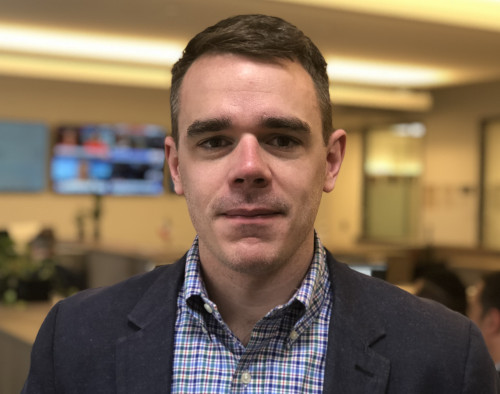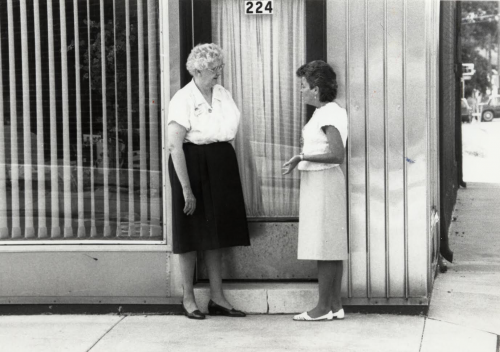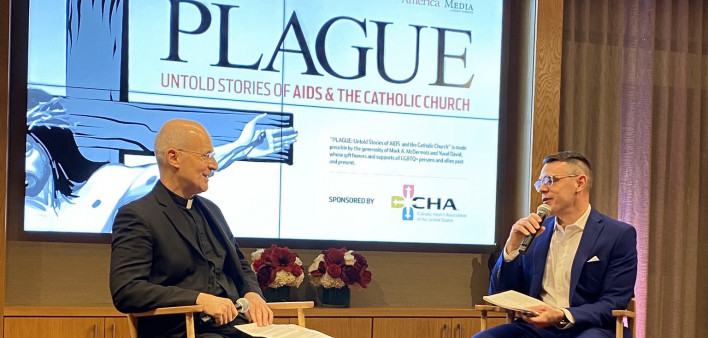Holy Week—the days leading up to Easter Sunday—is upon us. Regardless of your religious affiliation, or lack thereof, it’s an opportune time to check out the six-part podcast Plague: The Untold Stories of AIDS and the Catholic Church.
A common narrative of the HIV epidemic casts the Catholic Church as a villain of the HIV and LGBT communities. Not only does the church condemn homosexual acts as an “intrinsic moral evil,” but it has also been vocal against the use of condoms. The conflict famously came to a head in 1989 when AIDS activist group ACT UP New York held a disruptive protest called “Stop the Church” at St. Patrick’s Cathedral.
But there’s more to this story, and journalist Michael J. O’Loughlin, who is gay and Catholic, uncovers nuanced and compassionate viewpoints by interviewing people who were there in the ’80s and ’90s, inlcuding priests, LGBT parishioners and ACT UP protesters. Available for free on Apple Podcasts, Google Play and Spotify, the podcast is produced by the Jesuit journal America.
POZ recently interviewed O’Loughlin to get the stories behind the stories of Plague.

Journalist and host of “Plague” podcast Michael J. O’LoughlinCourtesy of “Plague”/Michael J. O’Loughlin
What’s your personal connection to the HIV epidemic, and how’d you first learn about it?
I’m gay and Catholic, and I’ve been reporting on the challenges that face LGBT people of faith for more than a decade. But because I’m too young to remember much about the height of the HIV and AIDS epidemic in the United States, I was unaware that the Catholic Church was such a major player during that time. A priest friend told me about his own ministry to people with HIV and AIDS in the ’80s, which he said helped shape his welcoming attitude toward LGBT people in the church. I was curious and started to explore more, digging through archives and cold-calling people who worked in that space to learn more.
Because the church was so heavily invested in health care ministry in the United States, it meant there was a huge confrontation between the church and the LGBT community, with many LGBT Catholics figuring out how they fit into everything. I ended up interviewing dozens of people and collecting hundreds of hours of audio. The result is the podcast Plague, which explores complex issues such as faith, sexuality, politics, public health and more. [Editor’s note: Listen to the first episode below.]
As for me personally, it’s been an incredible honor to get to know so many LGBT Catholics a few decades older than me who have walked a similar road, albeit with different challenges, and who are willing to share their stories with me and our listeners.
To honor the people who have been so generous with their stories, I’ve actually signed up for the AIDS LifeCycle. [Editor’s note: The 545-mile bike trek slated for early June and stretching from San Francisco to Los Angeles has been canceled due to the COVID-19 pandemic, though fundraising efforts continue.]

The doorway of the now-shuttered St. Vincent’s Hospital in New York CityCourtesy of “Plague”/Michael J. O’Loughlin
The church is well known for its charity work worldwide. Can you give us some examples of how the church cared for or supported the HIV/AIDS community?
There are the more well-known examples of how the church cared for people with HIV and AIDS during the height of the crisis, and we go into some of those in Plague. For example, we interview doctors, nurses, pastoral care providers and former patients at the now-closed St. Vincent’s Hospital in New York. This was a Catholic hospital run by the Sisters of Charity of New York that became a haven for the LGBT community in the ’80s and ’90s. Today its history is seen as inevitable, given that it was located in an area with lots of gay men, but as we show in the podcast, it was never guaranteed to turn out this way. The sisters had to step back and ask how they could do better after protesters pointed out that some gay patients had been subject to abuse and harassment from some of the hospital staff.

From left: Sister Carol Baltosiewich and Sister Mary Ellen Rombach cofounded an HIV resource cener in Belleville, Illinois.Courtesy of “Plague”/Michael J. O’Loughlin
We also introduce listeners to some of the less well-known examples of the church providing care, such as in the fifth episode, which covers a Catholic sister from a small city in southern Illinois who moved to New York for six months to learn about HIV and AIDS care before returning home and opening one of the first AIDS drop-in centers in that part of the country. And the Catholic priest who came out as gay early in the 1980s as an act of solidarity with the people living with HIV and AIDS whom he ministered to in New York. There are lots of examples like this of quiet, heroic work undertaken away from the spotlight.
We conclude the series with interviews of Catholics ministering to people with HIV and AIDS in South Africa, the nation hardest hit by HIV today. The Catholic Church is one of the leading providers of HIV and AIDS care in the world today, but, as we found out through our reporting, many of the debates that raged in the United States in the ’80s and ’90s are still going on internationally today. And, of course, as nearly everyone I interviewed noted, none of this work serves as an excuse for the homophobia many people experienced at the hands of other Catholics.
One of the recurring themes is how Catholics who are LGBT or support LGBT causes try to reconcile their faith with the staunch antigay teachings of the church. What insight did you gain on this struggle?
Almost every LGBT Catholic I interviewed mentioned that they had at one point or another thought about leaving the church because of bad experiences with homophobia. But many of them also said that to leave a parish they loved felt like giving into institutional bullying. I asked some of the people I interviewed for advice about how they made it work, and the answers generally included some variation of “once you decide to stay, you have to stand firm.”
David Pais is featured in our first episode, in which he tells us what it was like to be gay, HIV positive and Catholic in the 1980s. He actually left the church for a while, but, as he put it, he eventually decided he was going to stay and fight.

The AIDS memorial banner at Most Holy Redeemer Catholic church in San FranciscoCourtesy of “Plague”/Michael J. O’Loughlin
Cliff Morrison, the nurse who set up the AIDS ward [Ward 5B] at San Francisco General Hospital, told me his Catholic faith was a huge support during the height of the HIV and AIDS crisis. (His story is featured in the fourth episode of Plague.) He was a parishioner at Most Holy Redeemer Catholic Church in the Castro, and he said he struggled with the church’s stance on LGBT issues. But once he decided to stay, he stayed, and he actually helped revitalize the parish by going out into the gay community and inviting people in. He told me to rely on inner strength and to seek out allies in the church to talk to about my journey. That’s been hugely important to me—finding priests, sisters and laypeople who fully welcome the LGBT community into the church, not only tolerating us but celebrating and affirming our gifts.
Even today, there’s a lot of tension between the Catholic Church and HIV and LGBT advocates. You cover this a few times with regard to condoms and how some Catholic leaders found a way around the church’s stance against condoms. I particularly enjoyed the episode recounting an ACT UP protest at St. Vincent’s hospital I was unfamiliar with. However, to me, as a gay man in the United States, the condom issue pales in comparison to the church basically condemning homosexual acts as “intrinsically evil” and fighting (financially and otherwise) against marriage equality and for the right to discriminate against LGBT people, even today in 2020. What would you say to someone who views this podcast as an apologia for, or defense of, the church? I mean, it was interesting to learn in your podcast that New York Archbishop John O’Connor ministered, privately, to people dying from AIDS-related illness in the 1980s, but I suspect that anecdote would not change the minds of many New Yorkers from that time period who considered him an enemy of LGBT equality and HIV education and safe sex.
I can see why someone might make that critique, but I would encourage them to listen to the whole series. We sought to give voice to the people who lived, worked and grieved their way through the height of the HIV and AIDS crisis. Rather than tell people what to make of this history, we invite them to hear the stories of the people we interviewed—people living with HIV, people who lost loved ones to AIDS, people who protested the Catholic Church, people still recovering from experiences of homophobia—and draw their own conclusions.
I’ve heard from hundreds of listeners. Some have said they didn’t realize the church did so much in health care but added they don’t think that running hospitals excuses the homophobia that was present in the church at the time. One takeaway for me in making this series is the realization that many things can be true at once. There were intensely homophobic Catholics in the ’80s and ’90s, there were incredibly caring Catholics who did the right things during the height of the crisis and there were lots of LGBT Catholics struggling to make sense of it all. As for the church’s opposition today to things such as same-sex marriage and some nondiscrimination laws, we didn’t get into those issues in the podcast because we were focused on this unique period in our history. But I hope listeners will hear the very real debate still going on within the church about these issues.
On a lighter note, I was fascinated to learn about the patron saint of HIV/AIDS, St. Aloysius Gonzaga. I’m not a Catholic (I was raised Southern Baptist but am no longer practicing), so could you give some context as to whether having a patron saint of HIV/AIDS is a big deal and how it can be helpful to church members?
Basically, it depends. For many of the Catholics affected by HIV and AIDS whom I interviewed, having St. Aloysius Gonzaga as their patron saint was a sign that they weren’t alone in the church, that others empathized with what they were experiencing. The artwork depicting Aloysius, much of it created by Father Bill McNichols, whom we profile in episode three of Plague, helped bring awareness to the HIV and AIDS crisis. And on a spiritual level, some Catholics affected by HIV and AIDS truly felt they had a friend and advocate in the saint.

A poster at the Most Holy Redeemer church in San FranciscoCourtesy of “Plague”/Michael J. O’Loughlin
Why is it important to document the topics covered in Plague?
Sometimes because of the rapid advancement of LGBT civil rights in recent years, the issue of how LGBT people relate to the Catholic Church feels new. This can feel overwhelming at times because there isn’t a road map about how to handle things like being out in the church or getting married as a gay Catholic. So getting to know older LGBT Catholics has been hugely important because they have insight to share and stories to tell. And because it’s been about three decades since the start of the HIV and AIDS crisis, we risk losing those stories if we don’t capture them now. During the three years I spent researching the podcast, some of the people I sought to interview actually passed away, showing me the urgency we have in capturing these stories now.
What were you surprised to learn as you worked on this project?
Many things! But two things come to mind right now. First, the amount of work Catholics undertook in areas far away from the gay hubs on the coasts. For example, a group of Catholic sisters set up an organization to help people with HIV and AIDS navigate health care and housing challenges in Louisville, Kentucky, and another sister opened a drop-in clinic in Belleville, Illinois. And there are many more stories like that. Second, I was surprised to learn how out and proud many LGBT Catholics were in the ’70s and ’80s. This can be a taboo in many Catholic communities today, in 2020, so I was surprised at how vocal some LGBT Catholics were back then. In fact, a number of people told me they thought it was actually easier to be LGBT and Catholic 30 years ago.
What other feedback have you heard about the podcast, notably from the HIV community and from the Catholic community?
The reaction has truly been overwhelming. We got a great review from The New York Times and were featured on NPR. But most meaningful to me are the hundreds of emails, voice mails and messages on social media I’ve received from listeners. Many people want to share their own stories from the height of the HIV and AIDS crisis. More than a few have said no one has asked them about this traumatic period in their lives and they feel appreciative that they finally were given an outlet. That meant a lot to me because I feel like we owe the people who lived through this the chance to share what they learned or even to grieve anew. Some listeners have said they wish the church would teach more about this part of its history; others have said we painted too rosy a picture of how the church acted at this time. But mostly, people have expressed appreciation that the bulk of the podcast is people telling their own stories, which we did intentionally so that listeners can make up their own minds about what happened.







3 Comments
3 Comments